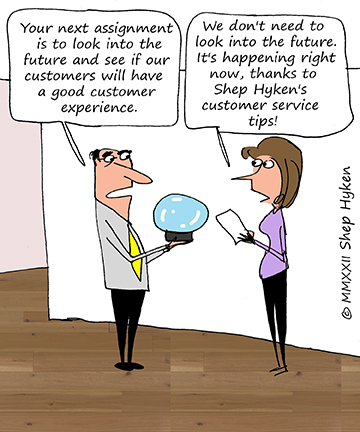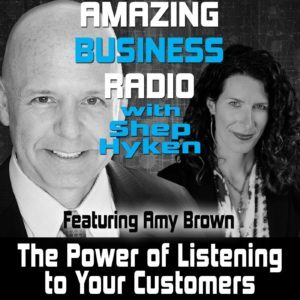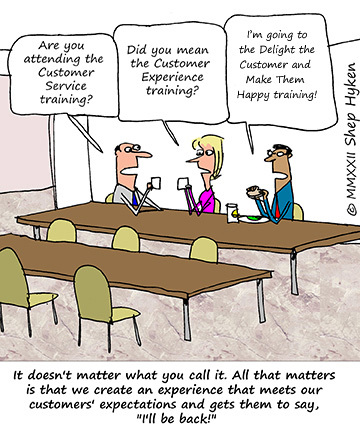Shep Hyken's Blog, page 51
January 2, 2023
5 Top Customer Service Articles of the Week 1-2-2023
Each week, I read many customer service and customer experience articles from various resources. Here are my top five picks from last week. I have added my comment about each article and would like to hear what you think too.
Customer Loyalty Is Your Holy Grail for Success. Here’s How to Cultivate It. by Matt Bertram(Entrepreneur) Customer loyalty is an essential source of revenue for any business. Use these four tips to create a customer loyalty program that will give you the highest return on your investment.
My Comment: How do we create customer loyalty? Let me count the ways! In this article, there are four of them, and two of them are worth paying close attention to. The first is to understand what motivates your customers. Make sure your incentives and perks align with what the customer wants. The second is to create consistent experiences. Anything less than a consistent experience erodes confidence.
6 Missteps By Walmart, McDonald’s And Others, And How They Can Fix Them by Jenn McMillen(CustomerThink) Change encourages adjustment, after all, and retailers had a lot to adjust to in 2022. Upon reflection, it’s likely many will recognize some missteps made while they were trying to keep pace with expenses and shifting shopper behavior. Here are six big ones.
My Comment: I love learning from major brands (like Walmart and McDonald’s). This time we take a look at loyalty programs and the changes these brands made that may need to be “fixed” in the near future. I am especially concerned with the third on this list, which is about the “lack of cost transparency.” This is where a customer is surprised about the price. This goes way beyond loyalty programs. For example, there is the surprise surcharge (a resort fee that was mentioned in the fine print) a hotel charges at checkout.
Creating the Best Customer Experience by Kari Polson(RIS News) An e-commerce storefront’s main function is to increase conversions through a seamless online shopping experience while an order management system’s main function is processing and servicing orders placed on the storefront. While e-commerce storefronts and order management systems have very different purposes, when used together they can scale operations, grow revenue, and power amazing customer experiences.
My Comment: This is a very short article with a very important – and often overlooked – piece of advice. When it comes to creating the “best” customer experience, don’t forget what happens before the sale. This applies to any type of business. It is important to identify every touchpoint the customer has with your company, and that includes the exploratory stage, which could be the customer’s research about what they are buying, not where or who they are buying it from.
7 Low-Cost Customer Service Options That a New Business Could Use by StartupGuys.net(StartupGuys.net) If you’re starting a new business, customer service might not be the first thing on your mind. However, if you want your company to grow and succeed, it’s important to provide good customer service. And just because you’re working with limited funds doesn’t mean that you can’t offer quality customer service.
My Comment: I’m a believer that customer service doesn’t cost, it pays. Yet there is an investment that must be made. For example, I’m always surprised when I call a company and the message I hear while holding is that my call is important to them. Then they don’t tell me how long I’m going to hold or give me the option to receive a callback. The technology solution that provides that experience is inexpensive. Still, some companies don’t invest in it and instead risk losing their customer, who gets frustrated and finds someone else to do business with next time.
Establishing and Protecting Your Brand’s Reputation Online by Patrick Jordan(Sprout Social) Building and maintaining your brand in a crowded market is no easy feat. According to Nielsen Media, as of 2022 there are over half a million brands globally. That’s a lot of competition for your audience’s attention. In these times of uncertainty and rapid change, consumers gravitate toward brands they trust. Building that trust isn’t your job alone, it takes a collective effort between yourself and your audience.
My Comment: Online brand management is a form of customer experience. As more and more of our customers interact on different social channels, it’s important to be there to participate in the brand story they are creating for you. This article has plenty of examples of how brands are participating in these conversations, sharing the causes and charities they support, and more.
[image error]Shep Hyken is a customer service expert, professional speaker, and New York Times bestselling business author. Go to The Customer Focus to learn more about our customer service training programs. Follow on Twitter: @Hyken
to learn more about our customer service training programs. Follow on Twitter: @Hyken
The post 5 Top Customer Service Articles of the Week 1-2-2023 appeared first on Shep Hyken.
December 30, 2022
Guest Post: What is Customer Experience (CX), and How to Improve It?
This week, we feature an article by FrontLogix, a CX outsourcing company that provides customer engagement solutions at a lower cost. They explain what customer experience is, how a BPO can help you achieve CX excellence, and provide seven suggestions for where to focus your CX efforts.
Customer Experience (CX) = customer’s overall perception of a brand.
CX is the sum of all customer experiences acquired at each stage of their customer journey – beginning with identifying a need and ending with choosing a service or product to meet it.
The advancement of digital technologies has had a significant impact on customer expectations. Over the last decade, technology pioneers offering novel services and disruptive solutions have significantly raised the bar for customer expectations. Products are no longer the primary differentiator for today’s customers – the experience a brand provides is. The latest research shows that the perceived quality of the experience is the most critical factor in influencing whether a customer makes a purchase.
As a result, businesses are no longer competing against other businesses that offer similar products or services. They also compete with brands that provide exceptional customer experience.
Today’s customers are no longer buying a product or service. They are buying an experience.
Ensuring a positive experience with the business at every stage of the customer journey can drive long-term customer satisfaction, retention, brand loyalty, and advocacy.
And the payoff for great experiences is substantial. According to a PWC study, there is a direct relationship between customer experience and increased revenue. They discovered that customer satisfaction could be quantified, as 86% of buyers claimed they would pay more for valuable experiences, with a price premium of up to 16% on items and services.
Given the significant benefits of improved CX, why aren’t more companies putting CX at the top of their priority list?The answer can be found in one (or all) of the following reasons:
It is costly They lack the necessary expertise They lack the necessary technology They are focusing on their core competenciesThese are all fair arguments for putting CX on the back burner. Still, each has one easy and common solution: partner with a Business Process Outsourcing (BPO) company to manage all your customer interactions and communications.
Outsourcing to a BPO partner can improve both your bottom line and your CX at the same time. BPOs provide workforce flexibility, cost savings through labor arbitrage, and access to technology otherwise not accessible in-house. Another reason to outsource is that BPO providers often have substantial knowledge and experience in the fields in which they deliver services. They can give higher quality and efficiency than your company could accomplish internally.
How to improve CXRedesigning customer journeys around CXThe customer journey is more than just a sum of individual touchpoints. You won’t reap the full rewards of your development efforts if you concentrate on improving individual interactions. Make sure you treat the customer experience as a journey spanning several touchpoints and use all available channels.
Start by mapping out the journey for each type of customer. Remember that customers will navigate your website for different reasons ‒ some will browse your products, while others will want to learn more about what you do or download your assets. Also, different customers prefer different methods of communication. Level up your CX by offering various contact methods, such as live chat, email, and in-person customer service.
Assessing real CX sentiment by listening and collecting feedbackThe second step is to conduct visitor testing on your digital channels and solicit feedback on your customer service. Customer suggestions, ideas, and complaints will help you identify areas for improvement and create better experiences. Surveys like the NPS (Net Promoter Score), CSAT (Customer Satisfaction), and CES (Customer Effort Score) can help you gauge customer satisfaction with your brand. These surveys will demonstrate whether you provide poor, good, or excellent customer service. You must first understand how well you serve your customers to improve your CX.
Personalized omnichannel experienceCustomers want brands to understand them and provide personalized solutions to their problems. Thanks to the rapid expansion of available communications channels, your customers are now everywhere. However, simply being present on all channels is not enough. To deliver a genuinely exceptional CX, all of these channels should be integrated and share customer data, allowing marketers to personalize each message, product suggestion, and experience based on each customer’s unique profile.
Here’s where omnichannel personalization comes in.
Omnichannel personalization integrates marketing, sales, and communication channels into a single customer database. So, when customers interact with a brand on one platform and then choose to continue on another, they can pick up where they left off.
With omnichannel personalization, customers may browse for an item on an app and finalize the purchase on a desktop computer. And after completing the purchase on the app, they won’t receive the same product suggestion when browsing on the website. Subsequently, if a buyer abandons an item in their shopping cart on one platform, they will see an advertisement for the same item on another.
An omnichannel strategy also offers many communication channels, which boosts customer service efficiency. The customer service agent can instantly refer to a customer’s prior purchases and interactions with customer services – reducing customer effort across interactions.
The omnichannel approach also offers additional flexibility. As a result of the back-end integration of channels, customers can seamlessly switch in the middle of an interaction.
Customers want friction-free communication and personalized solutions, which is exactly what the omnichannel experience offers.
Implementing self-service and AIWhile some customers will turn to agent assistance, others prefer the freedom of self-service. Self-service is where customers access resources to solve problems on their own. Empower them with self-service tools such as FAQ knowledge bases, AI chatbots, how-to video tutorials, and optimized IVR platforms.
Successfully implemented self-service pays for itself twofold. It not only improves the customer experience and satisfaction score but also boosts revenue. By enabling your customers to solve their problems, you will considerably minimize customer care call volume and the quantity of support needed.
Keep in mind that not every self-service solution is helpful. Complicated technologies and poorly configured chatbots that trap customers in endless loops can only contribute to increased dissatisfaction. While rule-based chatbots are limited to simple, linear conversations, next-generation AI may gauge the customer’s sentiment and communicate more naturally using Natural Language Processing (NLP). Continue investing in virtual assistance and chatbot technology and improve the website’s content findability.
Preserving the human touchWhen it comes to driving customer happiness (which can lead to more sales and improved loyalty), human connection outperforms operational metrics. In addition, the drive to ruthless operational efficiency has left many organizations vulnerable to customer attrition.
Although chatbots can resolve simple queries in seconds, they lack an agent’s empathy and problem-solving abilities. The ideal CX strikes a fine balance between human and digital.
With AI resolving simple requests, agents are left with more complex issues. That necessitates well-trained and knowledgeable agents capable of first-call query resolution.
To satisfy the full range of customer expectations, next-generation customer service requires ongoing investments in agent training and technology and a successful marriage of the two.
Offering customer support 24/7Customers want you to respond to their problems at all hours, including holidays and weekends. Outsourcing work to BPOs in different time zones allows you to be always online, allowing your organization to provide customer support around the clock, 365 days a year.
Optimizing workforce with Workforce Management (WFM)Workforce management (WFM) plays a significant role in running a contact center, with WFM teams handling various tasks to optimize staffing levels.
WFM can help you manage every part of your employee’s tasks. It significantly enhances operational efficiency, from tracking time and attendance to distributing work, scheduling shifts, budgeting, and forecasting demand.
WFM is critical to attaining optimal business, customer, and agent outcomes. As a result, most CCaaS solutions incorporate a WFM module, and expert workforce managers are in high demand.
The bottom line…No matter what industry you’re in, providing a high-quality CX could drastically improve customer loyalty and retention, increasing sales and profits.
Customers today have the power to influence how a business operates. The customer experience you provide plays an important role in the future success of your company, regardless of whether you offer superior goods. Ultimately, every business exists to serve its customers. As a result, customer experience has inevitably become a major focus for companies.
Customers expect customer support to be available around the clock, and traditional solutions can be costly in terms of labor and training. However, if you need professional assistance at a low cost, a high-quality BPO is always available. By prioritizing your CX, your brand’s reputation will be solidified as exceptional, giving you a competitive advantage over other brands in your niche.
FrontLogix is a boutique CX BPO that offers personalized and customer-centric CX solutions that are particularly suited to the client’s demands, resulting in outstanding results at a lower cost.
 For more articles from Shep Hyken and his guest contributors, go to customerserviceblog.com.
For more articles from Shep Hyken and his guest contributors, go to customerserviceblog.com.
Read Shep’s latest Forbes article: Are You As Good As You Think You Are? The Big Disconnect Between Brands And Their Customers
The post Guest Post: What is Customer Experience (CX), and How to Improve It? appeared first on Shep Hyken.
December 28, 2022
23 Ways to Create an Amazing Experience In 2023
 Happy New Year! I’m not one for New Year’s resolutions, which are often broken. Instead, I like setting and resetting my goals for the year, and in my world, those goals focus on delivering an amazing customer service experience. So, I’ve created a list of simple ways to deliver the experience that everyone wants. Here are 23 ways to help you and your teams provide an amazing customer experience in 2023.
Happy New Year! I’m not one for New Year’s resolutions, which are often broken. Instead, I like setting and resetting my goals for the year, and in my world, those goals focus on delivering an amazing customer service experience. So, I’ve created a list of simple ways to deliver the experience that everyone wants. Here are 23 ways to help you and your teams provide an amazing customer experience in 2023.
As you look at this list, you’ll see nothing complicated. The ideas may seem rather basic. But don’t be fooled by the simplicity. These are precisely the strategies and tactics that will make your customers say, “I’ll be back!”
Again, Happy New Year, and may 2023 be your best year yet – and each year better than the last!
Shep Hyken is a customer service expert, keynote speaker, and New York Times, bestselling business author. For information on The Customer Focus customer service training programs, go to www.thecustomerfocus.com. Follow on Twitter: @Hyken
customer service training programs, go to www.thecustomerfocus.com. Follow on Twitter: @Hyken
The post 23 Ways to Create an Amazing Experience In 2023 appeared first on Shep Hyken.
December 27, 2022
Amazing Business Radio: Amy Brown
 The Power of Listening to Your Customers
The Power of Listening to Your Customers Using Conversational Data to Enhance the Customer Experience
Shep Hyken interviews Amy Brown, founder and CEO of Authenticx, a software that listens, analyzes and activates customer voices at scale. She shares findings from Authenticx’s Customer Voices Report and how organizations can use data to drive customer experience strategies.






 Top Takeaways:Customers want to be empathized with and understood by the brands they interact and do business with.Customer centricity means taking intentional steps to listen to what your customer needs and having everyone, at all levels in the organization, committed to delivering on them.Typically, the customers who answer surveys are either very angry or very happy with your organization. However, this leaves out customers who are in the middle or think their experience is only satisfactory. When companies don’t learn from this segment of their customers, they often lose them once a competitor that does it better comes along.The value of listening to customers is that it teaches organizations the points of friction in their processes and identifies their competitive differentiators. It shows them the problem spots they need to pay attention and what drives negative sentiment. And it helps brands determine their value propositions using the words of their customers.When you hear good feedback and read positive testimonials, put that data into your process so that all your customers can have the same amazing experience.Frontline workers are a great resource when it comes to what customers are saying about your company and their experience. Train them to listen for customer insights, take notes, and share with everyone in the organization.Listen to your employees, too, not just your customers. Leaders must be listening for employee engagement and burnout. Turn positive and negative conversational data into actionable strategies that support your employees.Plus, Amy shares what The Eddy Effect
Top Takeaways:Customers want to be empathized with and understood by the brands they interact and do business with.Customer centricity means taking intentional steps to listen to what your customer needs and having everyone, at all levels in the organization, committed to delivering on them.Typically, the customers who answer surveys are either very angry or very happy with your organization. However, this leaves out customers who are in the middle or think their experience is only satisfactory. When companies don’t learn from this segment of their customers, they often lose them once a competitor that does it better comes along.The value of listening to customers is that it teaches organizations the points of friction in their processes and identifies their competitive differentiators. It shows them the problem spots they need to pay attention and what drives negative sentiment. And it helps brands determine their value propositions using the words of their customers.When you hear good feedback and read positive testimonials, put that data into your process so that all your customers can have the same amazing experience.Frontline workers are a great resource when it comes to what customers are saying about your company and their experience. Train them to listen for customer insights, take notes, and share with everyone in the organization.Listen to your employees, too, not just your customers. Leaders must be listening for employee engagement and burnout. Turn positive and negative conversational data into actionable strategies that support your employees.Plus, Amy shares what The Eddy Effect is and what it means to customer experience. Tune in!
is and what it means to customer experience. Tune in!Quotes:
“Customer-centric organizations believe that listening to and understanding what their customers want is vital to their ability to thrive as a business.”
“Having the ability to listen to customers at a large scale gives leaders the confidence that whatever strategies they are taking is backed up by data.”
“Use positive customer feedback to inspire your workforce, reward those delivering excellent experiences, and drive innovation.”
About:Amy Brown is the founder and CEO of Authenticx. As an executive with 20 years of experience in healthcare, she founded Authenticx to bring the authentic voice of the patient into the boardroom and increase positive healthcare outcomes.
Shep Hyken is a customer service and experience expert, New York Times bestselling author, award-winning keynote speaker, and host of Amazing Business Radio.
This episode of Amazing Business Radio with Shep Hyken answers the following questions and more:
What is meant by customer centricity?Why is voice of customer so important?Are customer surveys worth it?What does the voice of the customer mean in business?What is the difference between VoC and CX?The post Amazing Business Radio: Amy Brown appeared first on Shep Hyken.
December 26, 2022
5 Top Customer Service Articles of the Week 12-26-2022
Each week, I read many customer service and customer experience articles from various resources. Here are my top five picks from last week. I have added my comment about each article and would like to hear what you think too.
Customer Service Heroes: 5 Happy Holiday Tales by Cassandra Vincent(CSAT.AI) The holiday season is rife with customer service horror stories from both customers and workers. But there are the wonderful ones that keep the seasonal spirit alive and well. Here are happy holiday tales of customer service heroes to draw inspiration and good vibes from:
My Comment: If you’re reading today’s Top Five roundup on the day it was published, it’s the day after Christmas. I can’t think of a better way to start this week’s roundup than with this article that compiled five “Hallmark” type holiday stories. I’m honored the author included my story about the Ace Hardware manager that helped an older woman pick out her Christmas tree, delivered it to her home, and then decorated it with her. Happy Holidays!
13 Powerful Retention Strategies That Keep Customers Coming Back by Hirsh Goswamy(Forbes) In business, growth is generally associated with acquiring new customers. However, focusing solely on prospective customers can lead to excessive cash burn, which can rapidly jeopardize a company’s financial situation. To avoid such consequences, business owners should balance acquisition efforts with retention tactics. It is well documented that it is far less costly to retain existing customers, not to mention that there is a higher probability of customers repurchasing and spending more on subsequent orders.
My Comment: How can we get our customers to come back? Let me count the ways! Seriously, here are 13 ways that a group of savvy Forbes Council members compiled for us. There is something here for every type of business and industry.
2022 Look Back: Most Read Retail CX News of the Year by Retail Customer Experience(Retail Customer Experience) The year 2022 was a year of rebound, rebirth and technology as retailers, coming out of COVID-19, were centered on pulling shoppers back into stores while tackling a challenging supply chain scenario. Some retailers were still struggling to get inventory, others had too much and needed to alter marketing and merchandising plans.
My Comment: Here’s a look back at six of the most popular “headlines” in the retail world for 2022. A major retailer’s plans to expand, highly personalized apps, and more will give us an overall view of trends happening in retail.
Beyond Discounts: The New Rules for Today’s Top Loyalty Programs by Charlie Casey(Retail TouchPoints) Even in a time of increasing economic pressures, today’s consumers need brands to give them more than just discounts. They expect their favorite brands to connect with them on a human level. They want to feel like you’re listening to them, catering to their unique needs and aligning with their personal values.
My Comment: If you think that customer loyalty programs are about discounts and points, think again. While this is a very short article, it reminds us that discounts and points are marketing. True loyalty programs make customers feel special and connected to the company.
These Fatal Flaws Are Killing Brand Reputations by Asim Zaheer(Entrepreneur) With each passing year, these desires increase and it’s important to evolve congruently. Over 65% of customers say that their experience on a website or app is a major factor in their willingness to recommend a brand. Several poor choices are detrimental to the CX (customer experience), so here’s what companies need to stop doing on digital platforms in 2023.
My Comment: The online experience is just as important as an in-person experience. Your website is a direct reflection of your company/brand. Whether it’s eCommerce or a self-service customer support option, all interactions are essential to the customer being comfortable and confident about doing business with you. Don’t succumb to the “fatal flaws” covered in this article.
[image error]Shep Hyken is a customer service expert, professional speaker, and New York Times bestselling business author. Go to The Customer Focus to learn more about our customer service training programs. Follow on Twitter: @Hyken
to learn more about our customer service training programs. Follow on Twitter: @Hyken
The post 5 Top Customer Service Articles of the Week 12-26-2022 appeared first on Shep Hyken.
December 23, 2022
Guest Post: 2023 Top 5 Unified Communications Predictions
This week, we feature an article by Mitel, a company that works with teams by supporting their communications and technology needs so that they can provide the best customer experience possible. They share their top 5 unified communications predictions for 2023.
Predictable. It’s a word that organizations love to hear, but unfortunately, the past few years have been anything but. However, businesses must look ahead and plan – whatever it may bring.
Many organizations are modernizing their communications systems to streamline operations and keep employees (and customers) connected in a hybrid world. This was straightforward, but now unified communications (UC) technology is more than just IP phones and simple features like live chat. UC supports complex workflows across hybrid teams, and next year will likely be just as complicated.
Mitel’s leadership team sat down and looked into the UC crystal ball. Our prediction? 2023 will be all about customer lifecycle management (CLM).
Organizations will need a communications provider who evolves with them – a trusted partner who leverages their expertise and analytics to guide them toward the right solutions today and in the future. Delivering continued support during all phases of the customer relationship and adapting the UC technology stack as needs change will – predictably – be a key differentiator.
Mitel executives had more to say on CLM and what the unified communications landscape will look like in 2023.
Top 5 UC Predictions for 20231. A one-size-fits-all approach to unified communications will no longer work, as organizations require tailored solutions specific to their unique needs.
Customers have many communication technology choices today, and many use a mix of infrastructures.
“In 2023, the world’s business communications will occur across an increasingly dynamic and evolving panorama of on-prem, private cloud, hybrid, and UCaaS communications systems,” said Tarun Loomba, President and CEO of Mitel.
Currently, on-premise solutions are the most common, with 88% of organizations using some on-premises UC solutions, according to a recent five-country research survey conducted by Techaisle. The survey also found that 44% are combining on-premises solutions with a cloud solution, and almost half (47%) are either evaluating or currently moving their on-premises communications to the cloud.
“The most successful communications providers in the coming year will be the ones who commit to a CLM philosophy where solutions are offered with optimal choice and flexibility so they can be tailored to each organization’s needs,” said Loomba. “And the most agile and adaptive providers will be best positioned to navigate what is likely to be another unpredictable year.”
2. Communications systems will need to do more than support hybrid work as organizations require solutions that can help them adapt to changing conditions and modernize their business.
Hybrid work is taking the global workforce by storm, but the Techaisle survey found that only 11% of organizations have a hybrid-first mindset. There’s work to be done in 2023 to provide employees with the proper communications and collaboration tools to work from anywhere. But supporting hybrid work isn’t enough.
“In 2023, communications providers who prioritize a long-term commitment to CLM will win in the marketplace,” said Daren Finney, Mitel SVP of Global Channel Sales. “Now more than ever, mid-market and enterprise-level organizations are looking to help ensure their systems adequately enable hybrid work and provide the flexibility and future-proofing necessary to evolve in a fast-changing world.”
“Doing this effectively means supplying organizations with more than the latest communications equipment,” said Finney. “It means providing actionable data, insights, and proactive playbooks partners/providers can use to help their customers modernize their organization through communications.”
Organizations strongly believe in the value of a state-of-the-art system, with 84% saying that modern communications solutions are vital for business success. Nearly three-quarters (73%) say that such solutions drive business growth. Future-thinking providers who provide an innovative portfolio of UC technologies will be poised to support hybrid workers and help organizations modernize.
3. UC vendors and channel partners will need to fully embrace CLM as organizations seek guidance on the right communications solution that delivers long-term value for both the customer and employee experience.
With so many choices regarding communications technologies and deployment options, organizations want more than just a provider. This means a seamless relationship between UC vendors and their channel partners will be even more critical to ensure partners have the information they need to guide customers through complex and changing market conditions.
“The marketplace shift toward CLM will continue in 2023, and partner programs that fully embrace it will see the most engagement,” said Lana King, Mitel Vice President of Partner Programs, Training, and Enablement.
“Fully engaged partners given the right tools and data to respond to customer priorities are positioned to benefit the most from this focus on CLM as customers look to drive sustained value from their communications investments – now and into the future. To further support CLM, we will see a trend toward programs encouraging partners to embrace their role as trusted advisors throughout the customer experience.”
One way providers and partners can accomplish this is by helping customers choose the right communications technology to support hybrid work. More than three-quarters (78%) of employees surveyed by Techaisle agree that better communications and collaboration tools help them do their job better. Guiding customers toward solutions that provide shared workspaces, file and screen sharing, and a mobile-first design offer a quick and sustainable return on investment by empowering workers to collaborate and complete tasks from anywhere.
4. Generative AI will take off, resulting in an overload of content.
Generative AI can create content automatically. It has the potential to revolutionize certain aspects of business, specifically when it comes to content marketing and contact center communications.
The technology can produce marketing copy like newsletters, emails, and even blogs. It can also improve the chatbot experience on websites and provide personalized content to customers based on their history. In the contact center, Generative AI can produce content for agent coaching. It can also document and summarize interactions between agents and customers, creating content that can be used for training and development.
“Generative AI will see rapid adoption in 2023, with AI replacing SEO-focused content historically created by human beings,” said Venkat Nagaswamy, Mitel CMO. “So much so that we will have a content glut in a couple of years, and we will eventually come back to basics, focusing on higher quality but lower content volume.”
Leading communications providers need to stay on top of the role Generative AI will begin to play and be able to incorporate the content produced by it into their UC technology stacks.
5. CISOs will focus on recruiting employees to play a more significant role in preventing attacks and securing edge devices.
Cybersecurity continues to be a pressing issue for organizations. Phishing attacks, in particular, rose 61% in 2022, according to an annual study by Interisle Consulting Group. More than half (52%) of organizations are concerned about unauthorized access or leaks of their proprietary information.
“I see two significant challenges CISOs will be taking on in 2023,” said Arvind Raman, Mitel CISO. “The first is raising employee education and vigilance in avoiding ransomware, phishing, and other threats. Phishing attempts are getting more and more realistic and are coming in from not just email, but texts and social media.”
“While employers have a primary responsibility to secure their data, employees have a critically important role to play. In 2023, we’ll see increased investment in employee education, training, and awareness to actively recruit employees in the fight against bad actors.”
Organizations are also worried about applying adequate security and governance measures to the growing volume of data being used by a mobile workforce on both professional and personal devices. Roughly half of companies expect to spend between 11% and 20% of their edge investment on security, according to a recent AT&T survey.
“Securing a rapidly expanding universe of edge devices, both professional and personal, is the second challenge,” said Raman. “This is especially true for mid-market and enterprise organizations tasked with tracking tens of thousands of employees and hundreds of thousands of edge devices. You can’t protect what you don’t know you have, so auditing and securing a widely dispersed infrastructure will be key.”
Communications providers can help customers with the security battle by offering a software assurance (SWA) subscription that keeps customers up-to-date on the latest software, security fixes, and compliance requirements. Proactive performance monitoring gives customers the ability to control situations before they escalate. With SWA, customers have the peace of mind that their communications system is secure so that they can focus their efforts on employee training and awareness.
Predictability may be in short supply, but at Mitel, we’re confident the future of communications is focused on helping customers through every step of their journey. Innovative UC technologies combined with industry expertise make it possible to advise customers on the best choices for today and help them adapt to tomorrow.
The future may be uncertain, but a modern UC provider can provide the reliability and stability needed for long-term success in 2023 and beyond.
Mitel is a leader in business communications. Mitel empowers teams to collaborate and engage with customers by providing seamless, world-class communication tools.
 For more articles from Shep Hyken and his guest contributors, go to customerserviceblog.com.
For more articles from Shep Hyken and his guest contributors, go to customerserviceblog.com.
Read Shep’s latest Forbes article: Ten Customer Service And CX Predictions For 2023 (Part Two)
The post Guest Post: 2023 Top 5 Unified Communications Predictions appeared first on Shep Hyken.
December 21, 2022
Customers Don’t Know the Difference Between Customer Service and Customer Experience
 As I talk to people about their experiences with the companies and brands they do business with, they often use the terms customer service and customer experience interchangeably. Are they confused? Do they not know the difference? Maybe, maybe not. And in the end, it doesn’t matter. They don’t care, and neither should you.
As I talk to people about their experiences with the companies and brands they do business with, they often use the terms customer service and customer experience interchangeably. Are they confused? Do they not know the difference? Maybe, maybe not. And in the end, it doesn’t matter. They don’t care, and neither should you.
All you should worry about is giving them the experience they want, expect and deserve – regardless of what your customers call it.
Here are some of the different definitions the public gives to customer service:
Customer service is a group of people who help me when I have a problem or a complaint. Customer service is the way people treat me. Customer service is a friendly experience. Customer service is easy and convenient.And every once in a while, someone will use the words customer experience to describe the same. I’ve heard many other definitions of customer service and customer experience. The idea here is that customers have their definitions, and yours doesn’t matter. However, and this is important, regardless of how they define customer service or customer experience, the outcome needs to be the same: the customer always wants to be happy.
Now the word happy is my word. Customers will say they want to be happy, delighted, satisfied, pleased, and more. What drives all of that is an experience that might include friendly, knowledgeable employees, excellent customer support when there’s a problem, a simple, convenient experience, not having to wait, fast response times, employees who have empathy when it’s needed, and more. The list can get quite long, and it’s different for different types of businesses. Depending on your business, you may include something that other businesses might not.
In the end, does it really matter what customers call their experience? And does it really matter what we call it? The answer, as I’ve already mentioned, is no. What is important is that the company has every employee in alignment with what they want the customer to experience. It’s about the outcome. Whatever words we use internally, be it customer service, customer experience, or any other term that describes the outcome and process we want to create for the customer, it doesn’t matter. All that matters is that we create the experience that meets our customers’ expectations, makes them happy, and gets them to say, “I’ll be back.”
Shep Hyken is a customer service expert, keynote speaker, and New York Times, bestselling business author. For information on The Customer Focus customer service training programs, go to www.thecustomerfocus.com. Follow on Twitter: @Hyken
customer service training programs, go to www.thecustomerfocus.com. Follow on Twitter: @Hyken
The post Customers Don’t Know the Difference Between Customer Service and Customer Experience appeared first on Shep Hyken.
December 20, 2022
Amazing Business Radio: Jay Baer
 The Customer’s Need for Speed
The Customer’s Need for Speed In Customer Experience, Speed Equals Caring
Shep Hyken interviews Jay Baer, customer experience and marketing expert. He shares his findings from his new study, The Time to Win, and insights on how speed impacts customer experience and revenue.






 Top Takeaways:Time is the only inelastic resource. Time is the only thing everyone shares equally, regardless of who they are. We all have 1440 minutes a day, and there’s nothing we can do to get more.If you are slower than your customers expect and anticipate, they will feel like you are stealing time from them. And if you are faster than your customers expect and anticipate, they feel like you have given them the gift of time.The concept of “The Right Now” means the optimal amount of elapsed time in every customer interaction throughout the entire journey. “The Right Now” is slightly faster than customers expect.Jay Baer shares some important customer experience findings from his research, The Time to Win:There is a correlation between responsiveness and revenue. Two-thirds of customers say that speed is as important as the price. Customers are willing to pay more if it’s faster.Customers would pay up to 50% more if they never had to wait. For example, customers pay more for Disney’s Fast Pass/ Lightning Lane to skip the line at Disneyland.53% of American consumers have chosen a business that responded to them first, even if they were not the least expensive.Gen Z is the most patient generation. Baby Boomers are the least patient generation.Plus, Jay shares strategies to create better speed for our customers. Tune in!Quotes:
Top Takeaways:Time is the only inelastic resource. Time is the only thing everyone shares equally, regardless of who they are. We all have 1440 minutes a day, and there’s nothing we can do to get more.If you are slower than your customers expect and anticipate, they will feel like you are stealing time from them. And if you are faster than your customers expect and anticipate, they feel like you have given them the gift of time.The concept of “The Right Now” means the optimal amount of elapsed time in every customer interaction throughout the entire journey. “The Right Now” is slightly faster than customers expect.Jay Baer shares some important customer experience findings from his research, The Time to Win:There is a correlation between responsiveness and revenue. Two-thirds of customers say that speed is as important as the price. Customers are willing to pay more if it’s faster.Customers would pay up to 50% more if they never had to wait. For example, customers pay more for Disney’s Fast Pass/ Lightning Lane to skip the line at Disneyland.53% of American consumers have chosen a business that responded to them first, even if they were not the least expensive.Gen Z is the most patient generation. Baby Boomers are the least patient generation.Plus, Jay shares strategies to create better speed for our customers. Tune in!Quotes:“Speed is the most important component of customer experience and the only one that never pauses or goes backward. Customers’ expectations for speed and responsiveness escalate every year without fail.”
“Speed equals caring. Most customers believe that if it takes somebody a while to get back to you before they have your money, they might take longer once they have your money.”
“If you’re not consistently the first to respond to customers, it doesn’t matter how good you are or how much you charge, you are losing business.”
“The pandemic has permanently changed our society. It forced us to come face to face with our own mortality, and as a result, we care more about how we spend our time than we did two years ago. Wasting your customers’ time is a mistake that you have to stop making.”
About:Jay Baer is a customer experience and marketing expert. He is the author of six best-selling books, including, Youtility, Hug Your Haters, and Talk Triggers. His new study, The Time to Win, measures the impact of speed and responsiveness to customer experience and loyalty.
Shep Hyken is a customer service and experience expert, New York Times bestselling author, award-winning keynote speaker, and host of Amazing Business Radio.
This episode of Amazing Business Radio with Shep Hyken answers the following questions and more:
Why do customers care about speed and responsiveness? How did consumer behavior change during the pandemic?How fast do customers expect businesses to be?Does the speed of customer service affect revenue?How can businesses create better speed for their customers?The post Amazing Business Radio: Jay Baer appeared first on Shep Hyken.
December 19, 2022
5 Top Customer Service Articles of the Week 12-19-2022
Each week, I read many customer service and customer experience articles from various resources. Here are my top five picks from last week. I have added my comment about each article and would like to hear what you think too.
Here’s What Really Builds Customer Loyalty in the B2B Industry by Brandon Spear(Entrepreneur Media) While experience loyalty has been around the B2C world for decades, the B2B industry is now catching on that delighting customers doesn’t build loyalty. Instead, reducing buyer effort, or the work a buyer must do to get their problems solved, does. For today’s B2B customers, the “problem” that needs to be solved starts with the first purchase: Is it easy to start doing business with your company?
My Comment: What’s more important? How easy a company/brand is to do business with or a good customer service experience? It turns out that “easy” is the winner, with a much higher likelihood of getting the customer to come back. This article dives into different ways you can get the customer to come back and eventually be deemed a loyal customer.
PwC Report: Give Customers Good Reasons to Be Loyal to Your Brand by PwC(Hospitality Net) Here’s the good news this holiday shopping season: Consumers are open to trying new brands, which means the door is open for savvy consumer-facing companies to entice new customers by delivering on their fast-changing preferences. The not-so-good news? The flip side of the same finding: Consumers are trying new brands. That means consumer markets (CM) companies have to keep up with their customers’ fast-changing preferences. No more resting on your laurels.
My Comment: And as long as we’re on the subject of loyalty, here’s another article with several tips on how to get your customers to come back again and again. And there are some interesting stats and findings, including a section on branded credit cards and loyalty programs that are broken down by the four generations (Gen Z, Millennials, Gen X, and Boomers).
Customer Experience: 10 Tips for a Successful CX Strategy by Mary Pratt(CIO Online) Customer experience (CX) has become a top priority for IT leaders, who must embrace a customer-centric mindset, develop cross-functional teams, and define the right KPIs to succeed.
My Comment: If you’re in the C-Suite, this is a compelling list of tips for your CX strategy. This ties tech to CX. The article states, “57% of IT leaders say improving customer experience is a top goal, while 81% are implementing new tech to support customer interactions.” That’s good news for customers. Often in a shaky economy, companies and brands make the mistake of cutting back where customers notice. Kudos to the organizations that recognize the power of a good CX in more challenging times.
8 Customer Experience Statistics You Need to Know by Scott Clark(CMSWire) Pandemic fatigue has taken its toll, and chatbots are gaining ground, but for now, the phone is still king of customer service channels. Customer experience has taken on a new level of importance for brands in 2022. Post-pandemic fatigue has taken its toll, and customers are expecting and demanding an exceptional, omnichannel experience across the channels of their choice. Let’s take a look at eight customer experience statistics you need to know.
My Comment: I love stats, facts, and findings. Each year we conduct our own customer experience research, and I “geek out” over the numbers. Well, here are eight stats that will give you insight into the 2023 trends in CX. If you have a contact center or customer support department, be sure to pay attention to the section titled “Customer Service is Key to Exceptional CX.”
KPIs and Metrics Every SME Should Understand by JAM(JAM) Customer satisfaction is at the forefront of practically every business. A happy consumer base is key for both long and short-term goals – especially if you’re a smaller company that relies on repeat business and word of mouth.
My Comment: Business management guru Peter Drucker is credited with the line, “You can’t manage what you don’t measure.” But what are the KPIs and metrics you need to know? Here’s a guide to help you choose the right ones for your business. And even though the focus is on smaller and medium size enterprises, many of these KPIs and metrics are appropriate for larger companies. If you’ve wondered what metrics to pay attention to, this is a great resource.
[image error]Shep Hyken is a customer service expert, professional speaker, and New York Times bestselling business author. Go to The Customer Focus to learn more about our customer service training programs. Follow on Twitter: @Hyken
to learn more about our customer service training programs. Follow on Twitter: @Hyken
The post 5 Top Customer Service Articles of the Week 12-19-2022 appeared first on Shep Hyken.
December 16, 2022
Guest Post: The Concept of ‘Quiet Quitting’ and Its Impact on Contact Centers
This week, we feature an article by Stephen Holliday, CEO and Founder of Level, an on-demand pay platform that helps employees manage their financial well-being. He writes about ‘quiet quitting’ and how contact centers can resolve this challenge in their organization.
The concept of ‘quiet quitting’ has become a popular term within the working world. But what does ‘quiet quitting’ consist of?
‘Quiet quitting’ isn’t necessarily what the name suggests it to be. The concept doesn’t refer to someone who is slowly leaving their job. Instead, it’s about putting minimal effort in and abandoning the idea of progression or contributing any extra work.
For those who know they aren’t at risk of losing their job, ‘quiet quitting’ is the chosen strategy to minimize the stresses of work. It allows employees to cope with their unhappiness in a role without the pressure of needing to secure a new job.
This trend is concerning for those within the contact center industry, with employee retention and recruitment already at a record low. Staff is burnt out from the strenuous nature of the work, and it’s not a role that would be particularly successful if staff members were to ‘quiet quit.’
How can the contact center industry resolve this challenge?
Power in the hands of the employeeWith ever-increasing job vacancies across industries, the power within the workplace has fallen into the hands of the employee. Individuals have a wide variety of roles and job opportunities to choose from, while companies struggle to find enough individuals to fill their vacancies.
This newly empowered employee is demanding more from organizations around work, pay, and flexibility, and when organizations don’t meet these expectations, they’re left behind. Skilled employees will leave and find a company that will.
Employers need to understand staff desires and how to adequately meet them while sticking to a budget.
SalaryMany employers are out of touch with the true needs of their employees. While offering perks such as discounted gym memberships and ‘dress-down Fridays’ are all in good intentions, it doesn’t quite address what workers really want and need.
Employees want to be paid more for what they do. But that comes at a high cost, and sometimes it’s impossible to match salary expectations and continue to run a company profitably. For contact centers that have a very high number of employees, this issue around salary is exacerbated.
Aside from salary increases, what can those in the contact center industry do to meet the desires of their employees, while attracting new staff and retaining current workers?
Wage flexibilityThose at the top of a business control pay – not just how much an employee receives, but when they receive their paycheque.
The majority of the UK workforce is paid on a monthly cycle. Employees complete an entire month of work before they receive a paycheck. Employees desire more financial flexibility, and employers are recognizing their capacity to change it.
Financial well-being depends on more than just the sum of money that arrives in someone’s bank account each month. By giving employees the flexibility to choose how and when they’re paid, they gain further control over the money they’ve earned and are consequently able to manage their income in a way that suits their needs.
Yet employers can even go one step beyond this.
Supporting staff financiallySupporting staff financially doesn’t just mean paying them more. Employers could look to focus on financial education, savings accounts that take contributions at the point of payroll, and tools and reminders that are backed by behavioral science to better manage money.
Now, more than ever, it’s so important that contact centers are focused on supporting the financial well-being of their staff. Due to the cost-of-living crisis and the Great Resignation, those businesses which aren’t doing enough to support their staff will lose their workers’ loyalty.
The verdictFor their survival and growth, it is imperative that contact centers do all they can to fulfill the needs and desires of their staff. The concept of ‘quiet quitting’ doesn’t exist in a working environment where staff is supported in all aspects.
It’s understandable that fulfilling demands will be more difficult in the current economic downturn. However, there are so many other methods that show how businesses care and can support their staff. With such support in place, not only will ‘quiet quitting’ diminish but recruitment and retention will improve simultaneously.
Stephen Holliday is the CEO of Level Financial Technology, an on-demand pay platform that enhances employees’ financial well-being and helps employers improve attrition rates.
 For more articles from Shep Hyken and his guest contributors, go to customerserviceblog.com.
For more articles from Shep Hyken and his guest contributors, go to customerserviceblog.com.
Read Shep’s latest Forbes article: Ten Customer Service And CX Predictions For 2023 (Part One)
The post Guest Post: The Concept of ‘Quiet Quitting’ and Its Impact on Contact Centers appeared first on Shep Hyken.



